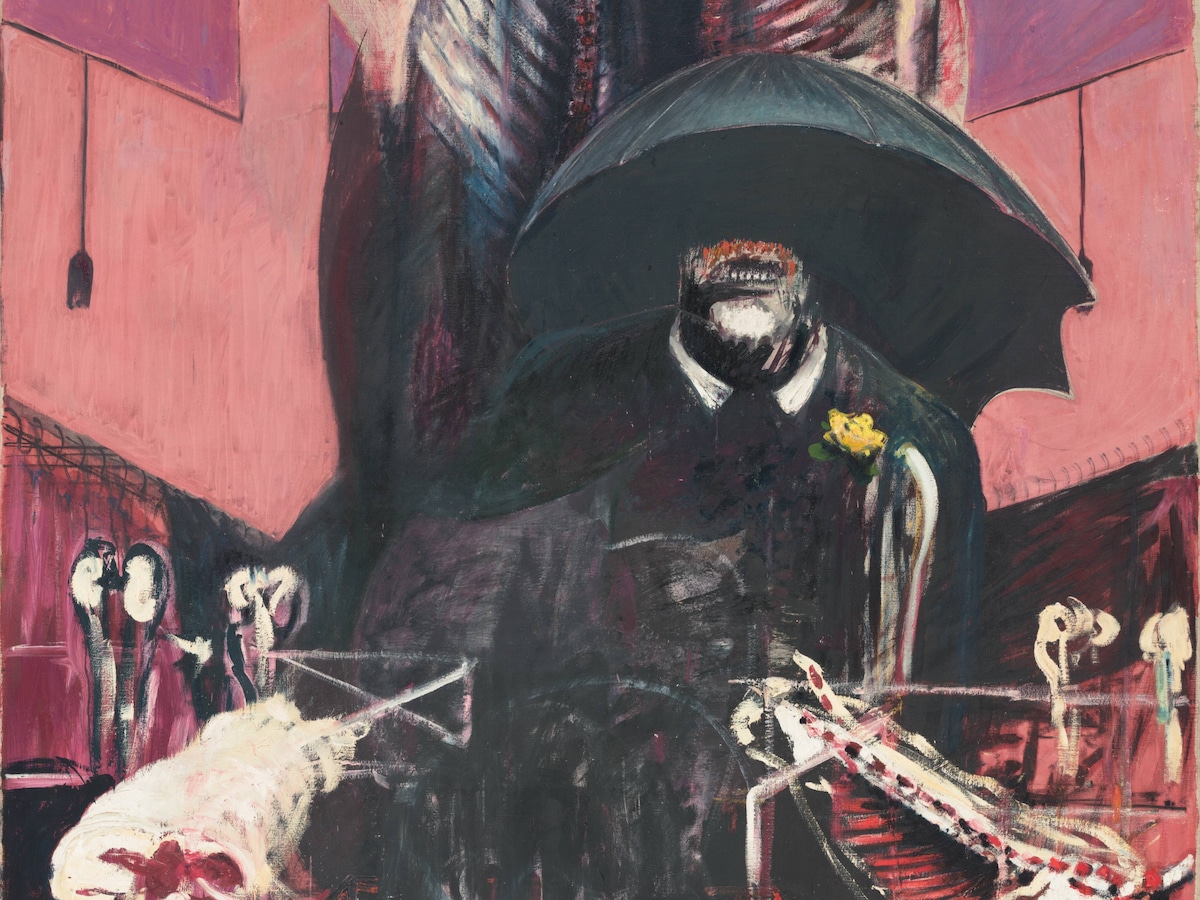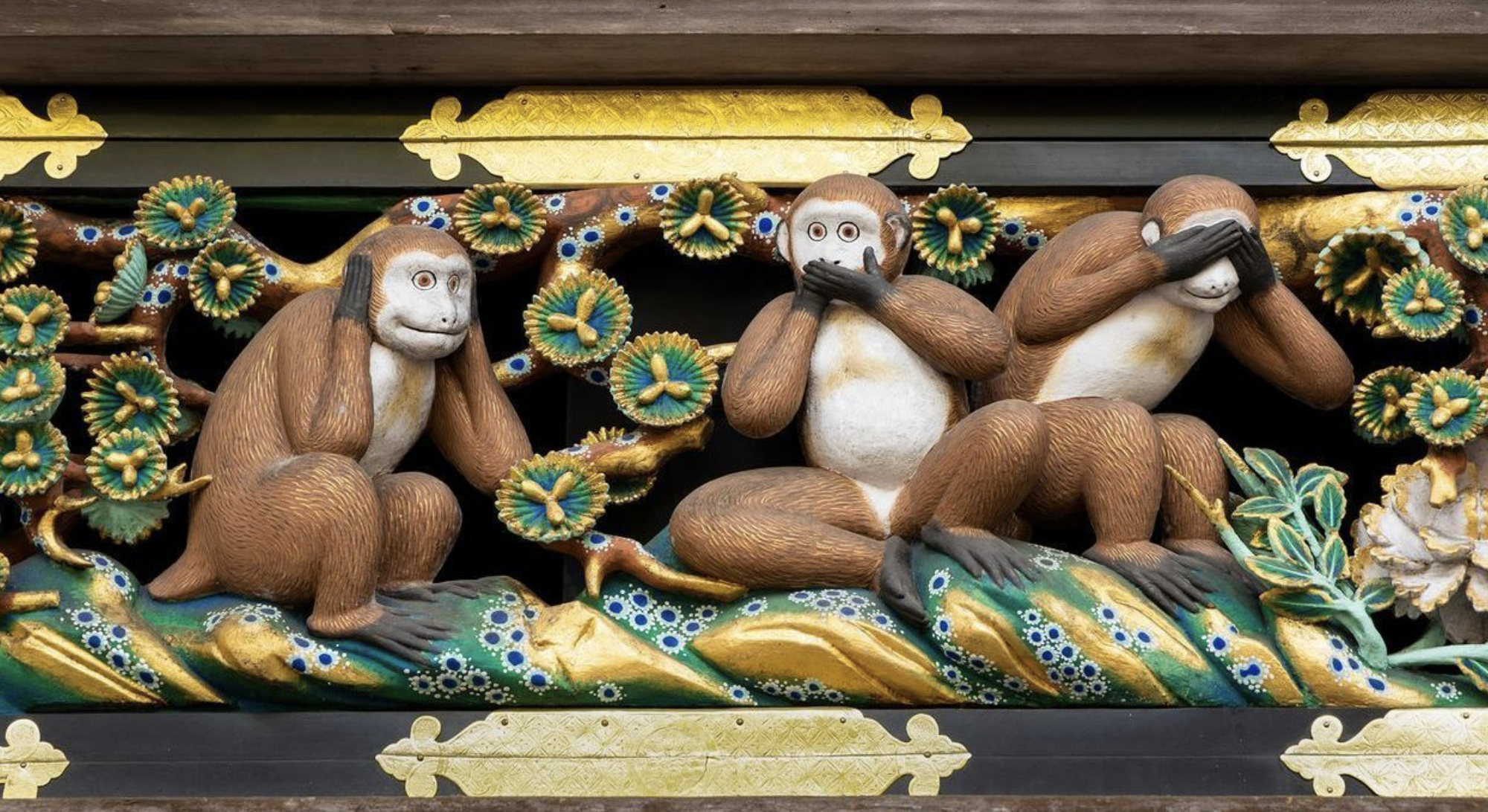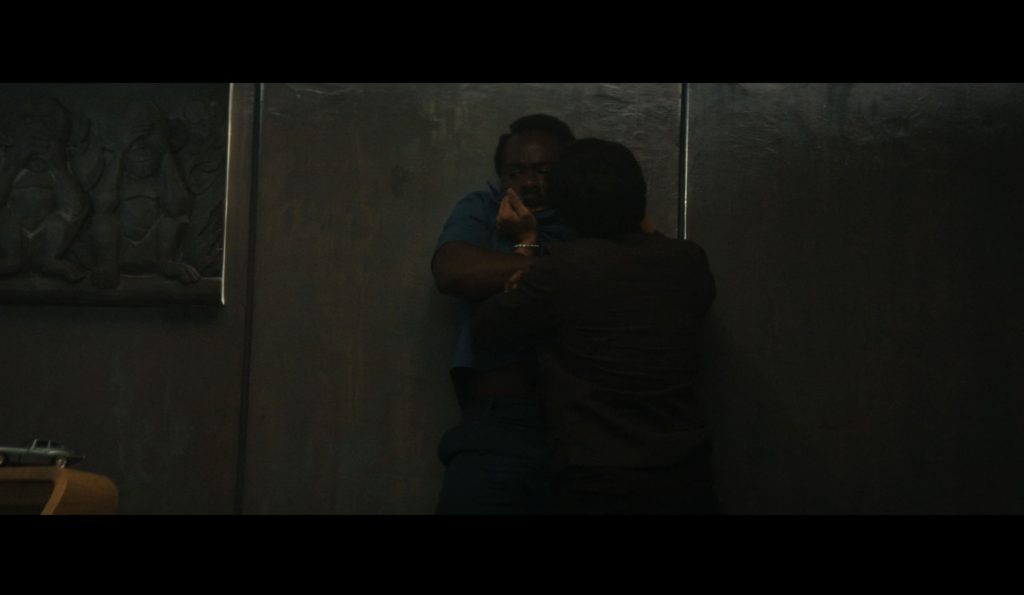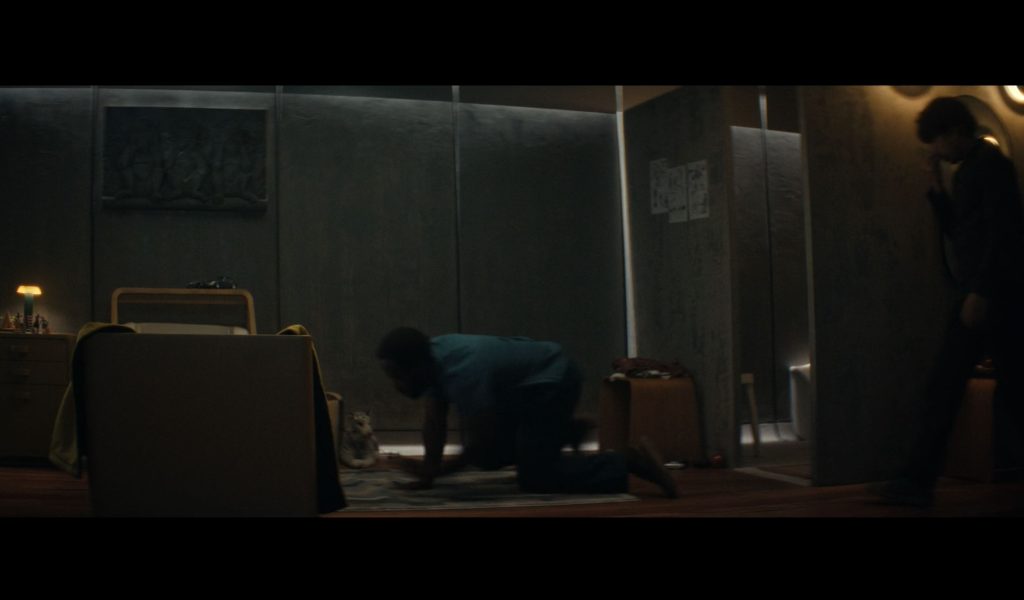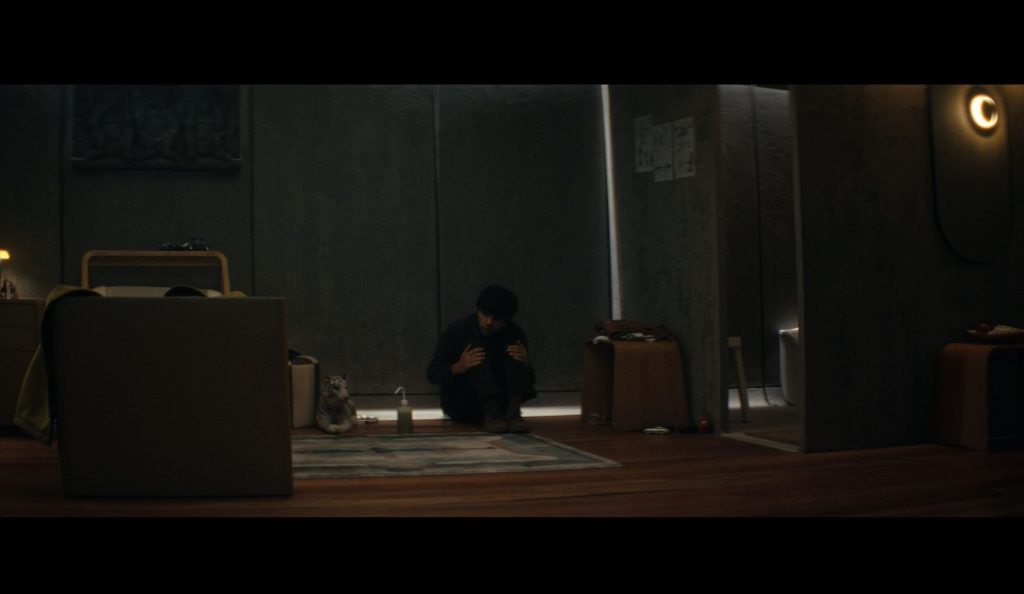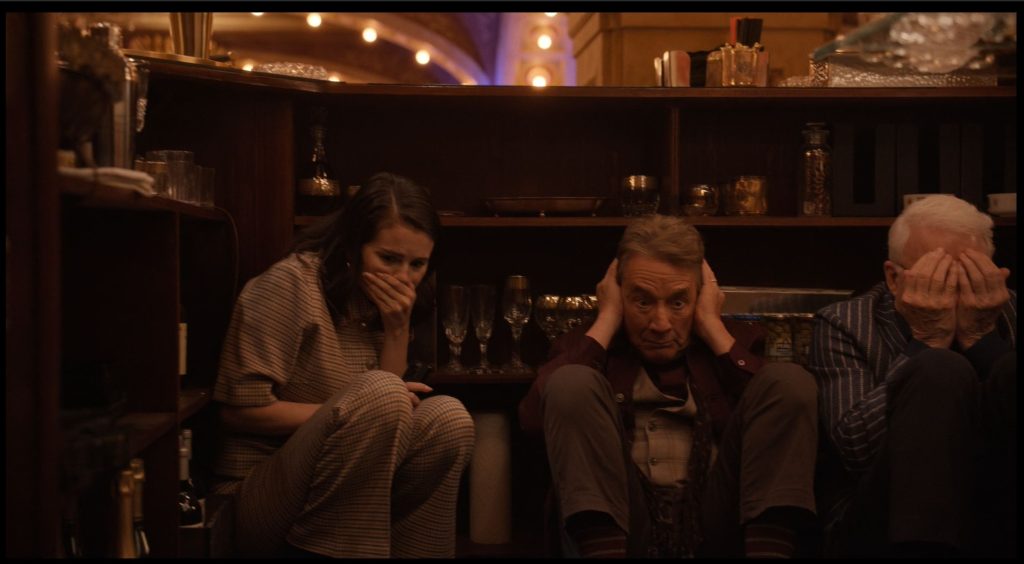
In the spectral interior of Painting (1946), a solitary figure occupies a suspended space, standing or perhaps hovering beneath an umbrella whose ribs inscribe a faint geometry across the violet air. Behind him, carcasses hang in sanguine suspension, their surfaces rendered with visceral immediacy that resists narrative containment, while a yellow boutonnière glows on the figure’s lapel with the precision of a small Rembrandtian sun. Curtains frame the scene like a stage, yet the space itself evades conventional depth, oscillating between theatre, interior, and liminal field. The image, scraped from the residue of catastrophe, does not pursue representation or abstraction in any conventional sense; it enacts the human body as an event within paint, registering its presence through tension, exposure, and gesture.
Before this work, Bacon’s early paintings had already revealed a fascination with the body as a site of dissolution and transformation. His prewar experiments, such as Crucifixion (1933), translated Expressionist and Surrealist vocabularies into a distinctly personal idiom, merging biomorphic abstraction with the residue of figuration. By the early 1940s, this interest in corporeal fragmentation reached its first major articulation in Three Studies for Figures at the Base of a Crucifixion (1944). There, distorted forms occupy a shallow, orange field, their mouths opened in silent convulsion, suggesting both scream and species—part human, part animal. The work’s triptych structure evokes religious painting while stripping it of transcendence, presenting flesh as spectacle and ordeal rather than redemption. The spatial compression and the emphasis on bodily distortion anticipate Painting (1946), where similar compositional tensions are reimagined within a more architectonic field. Between the two works lies a continuity of inquiry: the crucifixion as event becomes the grammar through which Bacon formulates a postwar phenomenology of the body.
Created in the immediate aftermath of the Second World War, Painting (1946) has often been read as an allegory of slaughter, a meditation on human destructiveness and the dehumanization of modernity, sometimes described in terms of “sacred violence.” Yet this reading risks imposing a moral narrative onto what Bacon approached as a phenomenological inquiry: the encounter with the body as matter, sensation, and site of perceptual engagement. In this sense, the painting is not a story about what happened to humanity, but a study of how the human figure emerges in paint, how forms coalesce under the pressures of gravity, space, and attention. The figure, the umbrella, and the surrounding carcasses operate within a unified visual ontology, each element a node in the network of perception that the painting constructs.
Bacon’s sense of embodiment is intensified by the historical moment, as the atomic bomb, the devastation of London from aerial bombing, and the collapse of Britain’s imperial order shaped his perception of the human body and its vulnerability. The postwar image-world, documented in photographs of ruins, mass graves, and the anonymous debris of cities, transformed the visible into a register of loss, where vision and memory were inseparable; to see was to recall, to witness, and to bear the imprint of catastrophe. Within this visual economy, Bacon’s figure appears precarious and contingent, dwarfed by forces political and technological as much as material. It does not restore order to experience but reveals the body as residue, caught within the circulation of destruction and survival that defined postwar perception. The painting enacts a phenomenology in which human finitude is measured against impersonal, almost cataclysmic forces; flesh becomes an emergent property, appearing only through its interaction with the conditions that undo it.
Bacon’s own account of the work underscores the primacy of emergence over prefiguration. He claimed the image “happened” to him, beginning as a bird alighting on a field and transforming into something grotesque, unbidden, and particular. In this methodology, accident is not a lapse of intention but a condition for the work’s very possibility. Each mark, smear, and overpainting becomes both material and event, a residue of process made visible. Art historians have identified a subtle echo of Poussin’s Adoration of the Golden Calf in these chaotic, contorted forms, where the human propensity toward frenzy, disintegration of order, and moral collapse are rendered through the careful choreography of bodies; Bacon internalizes and abstracts this, translating collective panic into a visceral, corporeal experience. The painting’s surfaces, shaped by the interplay of control and contingency, open a space for the viewer to apprehend the body not as symbol or narrative vehicle, but as a dynamic presence in time and space. The human figure appears as both phenomenon and condition of appearance, establishing a template for Bacon’s postwar practice in which body, matter, and perception are inseparable.
The body in Bacon’s work exists as matter before meaning. It is not a symbol, nor a vehicle for narrative; it is a residue of perceptual forces, a site where sensation, gravity, and temporal pressure converge. The surrounding carcasses reinforce this ontology of flesh, presenting mass and texture stripped of moral commentary, while the umbrella and suit, though formally distinct, are subjected to the same forces that govern the composition. Each element registers its presence through the tension of appearance rather than representation, even as critics have noted visceral associations with slaughter; as The Guardian observed, Bacon’s paintings recall the “smell of death” evoked by crucifixions and meat, yet this association emerges from perception rather than imposed narrative. The hanging flowers in the work allude to how butchers would manage this smell in their own shops.
Francis Bacon: Human Presence (2024), published by the National Portrait Gallery, offers a comprehensive look at Bacon’s portraiture from the 1950s onward, highlighting his psychologically charged approach, responses to other artists, and the development of his groundbreaking practice.
This attentiveness to surface, to the way flesh registers and refracts light, aligns with a broader epistemology of vision. Michael Baxandall’s concept of the “period eye,” describing historically contingent structures through which visual culture is perceived, resonates with Bacon’s approach in postwar Britain; the painter’s gaze is informed by photography, medical atlases, and wartime documentation, yet translated through a highly personal material practice. The body is dissected and catalogued not to convey scientific knowledge as Muybridge had done, but to make visible the conditions under which perception and sensation cohere. It is an epistemological inquiry enacted through paint.
Through this method, painting becomes a phenomenological operation. The surface records pressures, accidents, and iterative decisions of the studio while mediating the viewer’s encounter with the body. Portraiture is reflexive. Bacon establishes a principle that will define his postwar oeuvre: the human figure emerges through process and is inseparable from the physical, temporal, and perceptual forces that both produce and destroy it. Flesh is both object and event, and the work’s authority derives from its insistence on presenting the body as an active site of appearance rather than a preordained icon.
Camera: Francis Bacon – Photography, Film and the Practice of Painting by Martin Harrison examines how photographs, film, and media images shaped Bacon’s work. It traces influences from Velázquez, Poussin, Rodin, Muybridge, and Eisenstein, showing how these sources informed his painting practice and contributed to his stylistic development.
The environment around the main figure functions as more than backdrop; it actively shapes the experience of the body. Curtains, partitions, and the umbrella’s geometry organize the composition while simultaneously interrupting the gaze, producing a controlled yet unstable field of perception. These devices create a tension between containment and exposure: the figure is both framed and restrained, present yet partially obscured. The slatted geometry of the umbrella, and faint parallels to blinds or screens, introduces a subtle modulation of vision, suggesting that seeing is always mediated by structural conditions.
Through attention to framing and architecture, Bacon situates painting as an active negotiation between perception and presence. The visible world is not merely represented but interrogated; boundaries, partitions, and light conditions articulate the limits and possibilities of seeing, while the figure registers their effect. In this sense, the work functions simultaneously as a study of corporeal vulnerability and an exploration of the mechanics of vision, demonstrating that spatial organization is intrinsic to both the production and apprehension of the human form.
Francis Bacon: Painting, Philosophy, Psychoanalysis (2019), edited by Ben Ware, brings together essays exploring Bacon’s art through existential, phenomenological, and psychoanalytic lenses, engaging thinkers from Freud to Heidegger to illuminate his work and methods.
Painting (1946) gathers the formal and conceptual motifs that would shape Bacon’s postwar practice: the suspended figure, the carcass, the enclosing partitions, and the slatted geometries that regulate vision. Yet some of these elements predate the work itself and anticipate later developments. The figure’s dark suit and white collar recall the papal vestment in Velázquez’s Portrait of Innocent X (1650), while the partial enclosure evokes the architecture of both tribunal and confessional. These correspondences would resurface with full intensity in Head VI (1949) and the later Pope series, where the seated figure becomes the locus of both containment and exposure. The agape mouth reveals Bacon’s dialogue with the visual archives of the twentieth century, particularly the photograph of Joseph Goebbels at the Berlin Sportpalast, captured mid-oration with his mouth open in a gesture of command and fury. This image, a study in the performative collapse of authority, resonates alongside imagery from Eisenstein’s Battleship Potemkin (1925), where the scream becomes a register of terror and resistance.
Within this visual system, repetition operates not as redundancy but as investigation. Bacon revisits these motifs to test how the body, framed by its architectural and historical conditions, can register sensation without narrative mediation. Each recurrence refines the logic first articulated in Painting (1946), in which the figure is both object and event, suspended between enclosure and eruption. The later Pope paintings can be seen as variations on this initial grammar: they preserve the structure of the isolated body within a bounded field while deepening the tension between visibility and concealment that defines Bacon’s vision of postwar embodiment.
The spatial and material strategies crystallized in Painting (1946) consolidate concerns already present in Bacon’s earlier work, yet they also inaugurate the formal vocabulary of his postwar practice. Motifs (Rosie Broadley calls them ciphers) such as the suspended body, the enclosing framework, and the calibrated interplay of light and shadow had appeared in tentative form before 1946, but here they achieve a structural and conceptual coherence that would persist through the 1950s and 1960s. In the triptychs and later variations on the reclining figure, Bacon returns to these devices not through repetition alone but as a method of inquiry and study; each reengagement tests how flesh, form, and perception are continually reconstituted within the material field of painting.
Ultimately, Bacon’s work is significant not for a single figure or scene, but for the method it establishes, rendering the human body in all its fragility and intensity. His portraits function as studies of others and of himself, with painting acting as both mirror and medium, where perception, gesture, and material presence converge. The body emerges through interaction with space, light, and paint, enacting a subtle phenomenology in which flesh and vision co-arise. Portraiture becomes a site of inquiry, where artist, subject, and viewer intersect, and where the conditions of appearance are examined as rigorously as the forms themselves.
Books consulted in this analysis:
- Camera: Francis Bacon – Photography, Film and the Practice of Painting by Martin Harrison
- Francis Bacon: Books and Painting edited by Didier Ottinger
- Francis Bacon: Painting, Philosophy, Psychoanalysis edited by Ben Ware
- Francis Bacon Human Presence by Rosie Broadley
- Francis Bacon edited by Matthew Gale and Chris Stephens


